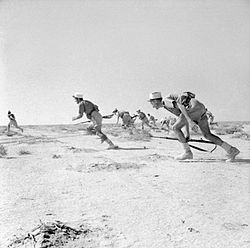
Back معركة بئر حكيم Arabic بئر حکیم دؤیوشو AZB Batalla de Bir Hakeim Catalan Bitva o Bir Hakeim Czech Brwydr Bir Hakeim Welsh Schlacht von Bir Hakeim German Batalla de Bir Hakeim Spanish نبرد بئر حکیم Persian Bir Hakeimin taistelu Finnish Bataille de Bir Hakeim French
| Battle of Bir Hakeim | |||||||
|---|---|---|---|---|---|---|---|
| Part of the Battle of Gazala | |||||||
 Free French Legionnaires wearing distinctive kepi hats "leap up from the desert to rush an enemy strong point". | |||||||
| |||||||
| Belligerents | |||||||
|
| |||||||
| Commanders and leaders | |||||||
|
Marie-Pierre Kœnig Dimitri Amilakhvari |
Ettore Bastico Erwin Rommel | ||||||
| Strength | |||||||
| c. 3,723 men | 37,000–45,000 men[1] | ||||||
| Casualties and losses | |||||||
|
141 killed 229 wounded 814 captured 53 guns 50 vehicles 110 aircraft |
3,300 killed or wounded 227–845 captured 164 vehicles 49 aircraft | ||||||
| Bir Hakeim was first attacked by the "Ariete" Division early in the Battle of Gazala, then by a mixed force of the "Trieste" and 90th Light divisions. | |||||||
Location within Libya | |||||||
The Battle of Bir Hakeim (Arabic pronunciation: [biʔr ħaˈkiːm] ) took place at Bir Hakeim, an oasis in the Libyan desert south and west of Tobruk, during the Battle of Gazala (26 May – 21 June 1942). The 1st Free French Brigade under Général de brigade Marie-Pierre Kœnig defended the position from 26 May – 11 June against Axis forces of Panzerarmee Afrika commanded by Generaloberst Erwin Rommel. The Panzerarmee captured Tobruk ten days later.
The delay imposed on the Axis offensive by the defence of Bir Hakeim influenced the cancellation of Operation Herkules, the Axis invasion of Malta. Rommel invaded Egypt, slowed by British delaying actions until the First Battle of El Alamein in July, where the Axis advance was stopped. Both sides used the battle for propaganda, Winston Churchill declared the Free French to be the "Fighting French".
- ^ Grant 2017, p. 833.

